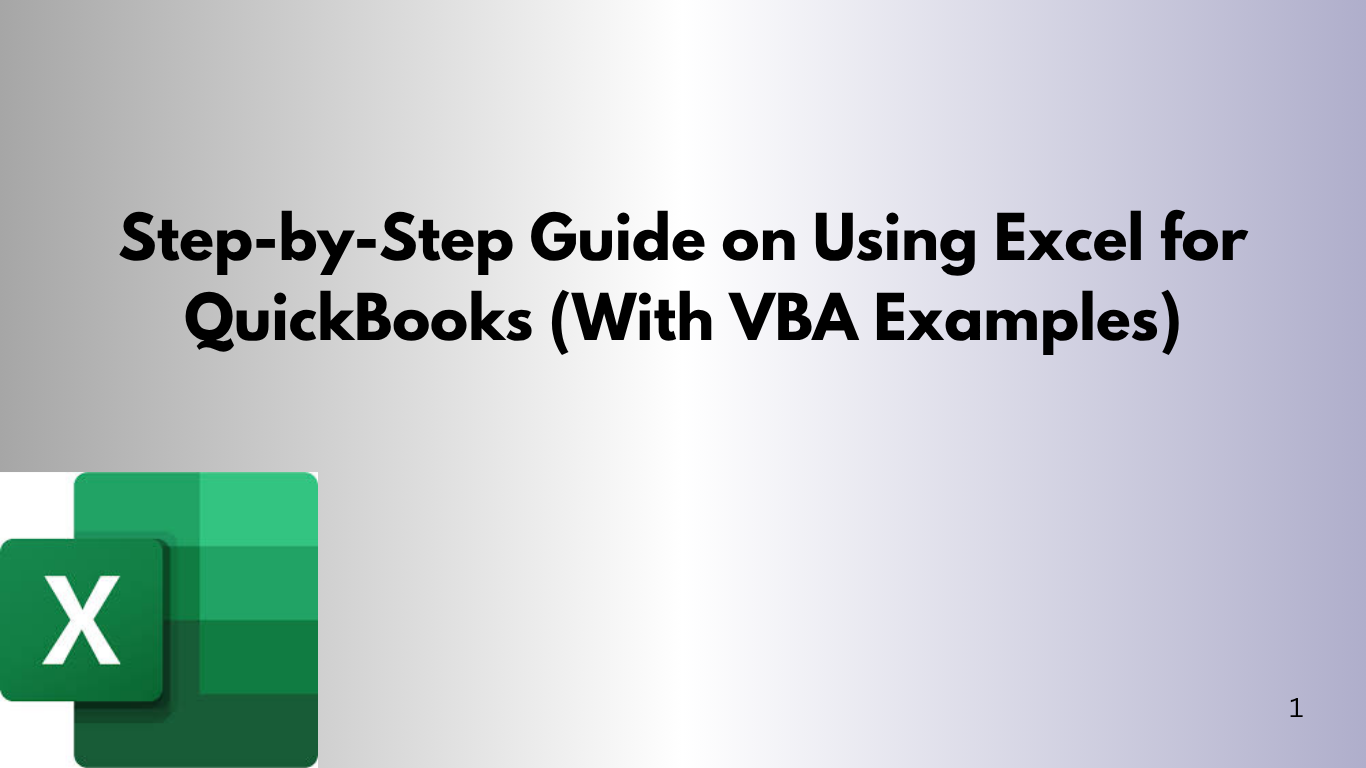Keyword focus: QuickBooks Excel integration, Excel VBA for QuickBooks, automate QuickBooks with Excel, export QuickBooks to Excel, QuickBooks reporting Excel
Introduction
QuickBooks is a top accounting software used by over 5.3 million businesses worldwide (Intuit, 2024). Yet, many users find it hard to do custom reporting, bulk data manipulation, and automated processes.
Microsoft Excel is a great tool to use with QuickBooks. It helps automate workflows, create dynamic reports, and boost productivity. In this article, we'll show you how to use Excel with QuickBooks step by step. We'll include examples and VBA code to help you automate tasks.
Why Use Excel with QuickBooks?
Using Excel with QuickBooks offers:
- Advanced reporting: PivotTables, dashboards, charts
- Data analysis: Use Excel formulas and Power Query
- Bulk editing: Clean and modify large data sets
- Automation: Use VBA to save time
- Customization: Tailored reports your business actually needs
Step 1: Export Data from QuickBooks to Excel
Method 1: Manual Export
- Open QuickBooks Desktop or Online
- Go to the report or list you want (e.g., Profit and Loss)
- Click “Export” > Export to Excel
- Save the Excel file
Method 2: Use QuickBooks Excel Add-In (e.g., from CData or Intuit SDK)
This allows live linking to QuickBooks data and is best for recurring reports.
Step 2: Clean and Format Data in Excel
Once your data is exported:
- Remove unnecessary columns
- Use TRIM(), CLEAN(), or TEXT() to format data
- Convert numbers using VALUE() if necessary
- Use Excel Tables (Ctrl + T) for easier management
Example:
=IFERROR(VALUE(TRIM(A2)), "")This converts a messy text number into a clean numerical format.
Step 3: Automate Reports with PivotTables and Charts
Create a dynamic dashboard in Excel:
- Insert PivotTable (Insert > PivotTable)
- Use filters like date ranges or customer names
- Add Slicers for interactivity
- Insert PivotCharts for visual summaries
Tip: Use GETPIVOTDATA() to reference specific Pivot values.
Step 4: Use VBA to Automate Tasks
Here’s where Excel really shines. With VBA (Visual Basic for Applications), you can:
- Refresh QuickBooks exports
- Format data
- Create reports with a click
Example 1: Simple VBA to Clean and Format QuickBooks Data
Sub CleanQuickBooksData()
Dim ws As Worksheet
Set ws = ActiveSheet
With ws
.Columns("A:C").EntireColumn.AutoFit
.Range("A2:A1000").Value = Evaluate("IFERROR(VALUE(TRIM(A2:A1000)), """")")
End With
MsgBox "QuickBooks data cleaned successfully!"
End Sub
Example 2: Refresh QuickBooks Linked Table Automatically
If you’re using a linked query:
Sub RefreshQuickBooksData()
Dim qt As QueryTable
For Each qt In Worksheets("QuickBooksData").QueryTables
qt.Refresh BackgroundQuery:=False
Next qt
MsgBox "Data refreshed from QuickBooks"
End Sub
Step 5: Schedule Your Reports with Power Automate or Task Scheduler
You can schedule the Excel workbook to open and run macros on a schedule using Windows Task Scheduler or Power Automate Desktop:
- Save Excel file with macro
- Create a .bat file to open it
- Schedule the .bat file to run daily or weekly
Step 6: Import Modified Data Back to QuickBooks (Advanced)
QuickBooks Desktop: Use IIF files for import:
- Save Excel file as .csv
- Convert to .iif using QuickBooks IIF Import Kit
- Go to File > Utilities > Import > IIF Files
QuickBooks Online: Use apps like:
- Transaction Pro
- Saasant
- Zapier
Tips for Success
- Always backup QuickBooks before import
- Keep column headers consistent
- Test with a small data set
- Validate formatting (dates, currency, etc.)
Real-World Use Case
Client: A small retail business
Problem: Manually exporting sales data from QuickBooks Online to generate monthly profit reports
Solution:
- Export data via QuickBooks Online to Excel
- VBA macro formats and builds PivotTables
- Dashboard auto-refreshes with a button
- Reports shared via Teams using OneDrive link
Time saved: ~4 hours/month
Key Stats to Know
- 75% of small business users say QuickBooks lacks custom reporting features (Gartner, 2023)
- Businesses using Excel automation report up to 30% improvement in efficiency
- Excel is still used by over 80% of accountants for custom reports
Conclusion
Using QuickBooks with Excel gives your business the best of both worlds. You get robust accounting and flexible reporting and automation. Whether it's managing monthly reports or automating reconciliations, mastering Excel for QuickBooks can save time and unlock insights.
Resources” or “Helpful Links”
📘 QuickBooks Excel Add-Ins
CData Excel Add-In for QuickBooks Desktop
This add-in allows you to connect Excel directly to QuickBooks Desktop, enabling real-time access to your QuickBooks data within Excel.
CData Excel Add-In for QuickBooks Online
For QuickBooks Online users, this add-in facilitates seamless integration, allowing you to work with live QuickBooks data in Excel.
Devart Excel Add-In for QuickBooks Online
This tool offers advanced SQL support, enabling you to import, edit, and export QuickBooks Online data efficiently within Excel.
📊 Automating QuickBooks Data with Excel
Coupler.io Guide: How to Export QuickBooks to Excel
Learn how to automate the export of QuickBooks data to Excel, allowing for scheduled updates and streamlined reporting.
Zapier Integration: QuickBooks + Excel
Automate workflows between QuickBooks and Excel using Zapier, enabling seamless data transfer and task automation.
🛠️ Importing and Exporting Data
Devart Guide: Importing and Exporting Excel with QuickBooks
A comprehensive guide detailing how to manage QuickBooks Online data using the Devart Excel Add-In, including importing and exporting data efficiently.
Method: QuickBooks Import Excel and CSV Toolkit
This toolkit provides resources and step-by-step instructions for importing data into QuickBooks from Excel and CSV files, minimizing errors during the import process.
